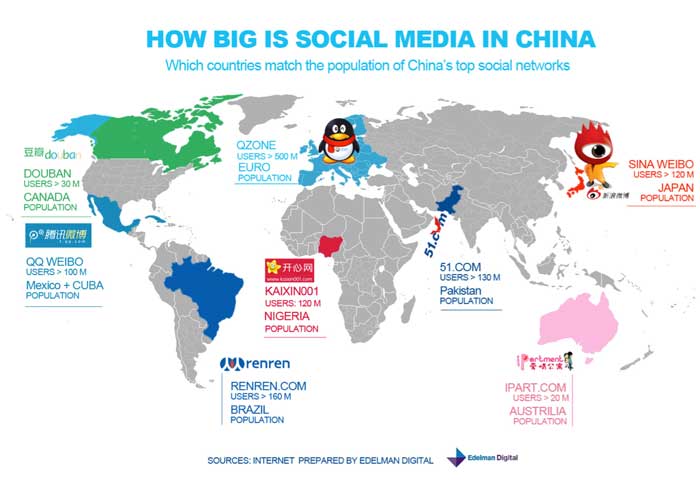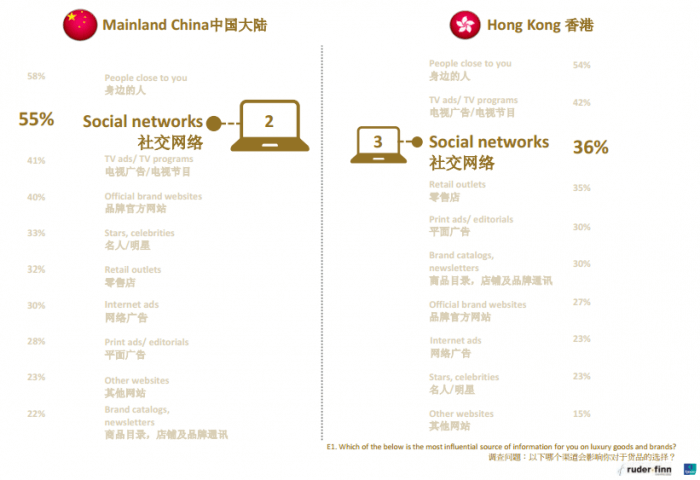In recent years China has become the beckoning target of cooperating partner with its growing economy. It becomes enticing, no longer only for her cheap labour but for the growing consumer market. In the coming years, China will probably become more important in terms of business sector. Yet, it is essential to acknowledge the business cultural differences emerged which could lead to misunderstanding and thus failure.
Regarding the online marketing environment, it is known that China has a large scope of land with 56 ethnic groups and people with vastly varying levels of affluence, cultures and interpretations and tastes. It is no surprise that online marketing is more common than offline marketing. Here we would like to discuss few aspects including social media, search engine and online shopping.
Social Media usage in China
To make an important remark as background information, China’s web users make up 47 percent of China’s population. Among these 600 million web users, almost 500 million of them are social network users, which is equivalent to the population of the entire European Union. Therefore, it is more prevailing to utilize the social media platforms rather than traditional and ordinary marketing strategies so as to reach as much population as possible. Nevertheless, it is reminded that the situations are very different between China and that in Hong Kong. In short, China is like a separate individual with its domestic practice of net-surfing whereas Hong Kong tends to adopt the western practice which is shown in figure I.

When it comes to online platforms for advertising, we usually think of Facebook, YouTube and Twitter. However, since they have been blocked in China since July 2009, domestic social networking platforms have a fierce battle within China and now Sina Weibo (in Figure I), Tencent Weibo (or sometimes it is called QQ Weibo) and Wechat (in Figure I) have become the leading ones these two years. By comparison, Sina Weibo is the closest equivalent of Twitter while the other two are like Facebook with over 50% of market share in total.


From 2009 to 2015, the number of social network users has increased from 155 millions to 488 millions.

Figure IV above shows the number of users of different social media in terms of different population in the world. Sina Weibo has about 120 million of users which is similar to the population of Japan while Tencent owns about 100 million of users which is the population of Mexico plus Cuba. The one with the largest population of registered accounts is QZone, that is almost equal to the entire group of social network users in China, 500 million. However, one point to note about QZone is that regardless of the huge amount of accounts, its popularity is gradually edging down for the rise of Tencent and Wechat. The latter one is not shown in the figure because it is not a pure social network platform but also with the function of whatsapp. Similar situation happens to Renren, which 99% looks like Facebook but mainly for students. Now, it is declining since most people abandon it after graduation. In other words, in some cases, although some platforms grab a large amount of users, they might not be active users and thus they are not an effective medium to approach audience.

According to the statistics in Jan 2015, the top three social network platforms are Sina Weibo, QZone and Tencent Weibo whereas the most frequently used chat application (app) is Wechat which operates like Whatsapp but with additional internal social network platform.

As observed from Figure VI, we can see that Tencent is really playing an integral role among all China social platforms with the market capitalization at $185 billion. It is commonly believed that Whatsapp is renowned nowadays all around the globe. However, it is patent that Wechat in China is much more popular as it is invented by a Chinese company – Tencent. Though Sina Weibo takes up the biggest proportion in Figure II, indeed, Tencent is still very influential in the market.

This graph shows a comparison of China social platform to the ordinary common social platforms. Basically, The two Weibos would be functioning like a mixture of Twitter and Facebook while part of WeChat would be like Whatsapp apparently.

As described in the above figure, Weibo has totally permeated into Chinese people’s lives. The blockage of websites and information might be attributive to the popularity of Weibo in China and this is how Chinese people communicate most frequently in social platforms.
Search Engine usage in China
Again, even the search engines of China are different from the usual ones used by us such as Google and Yahoo!. Instead, Chinese people prefer Baidu which has the market capitalization at $72 million. Figure IX below describes the overarching view of China.

This figure reflects that the most prominent search engines are Baidu, 360 and Sogou. Google only takes up 2.9% of the market share in China. The Chinese search engine leader Baidu is going to announce earnings next Monday. It is forecasted with sales of $2.67 billion, Baidu is expected to report net income of $608 million, up 8.8% over the same period a year ago.
Online Shopping in China
For online shopping platform, the alternatives of eBay or Amazon in western countries are called Taobao (taobao.com) and Tmall (tmall.com) from Alibaba Group which is a sought-after medium to reach almost 500 millions registered customers in China and other Asia Pacific regions. The vivid character of them is you can almost buy everything at an extremely low price. There is a base of regular 60 millions of shoppers daily with the record of selling 48k pieces of products every minute for Taobao.
From a CNN news in September 2014, analysts say Alibaba could be worth as much as $200 billion. That’s almost the market cap of Amazon and Ebay combined.
As aforementioned, the social network platforms play an important role to Chinese people’s life. The same case applies to their shopping habit as well. By referring to the data collected from Red Luxury in 2014, it is found that 51 percent of mainland Chinese respondents said social media was relevant to their life, and 31 percent said it was “completely relevant to my life.” In Hong Kong, 48 percent of respondents said social media was relevant to their lives, and 13 percent said it was completely relevant to their lives. (http://red-luxury.com/trends/how-did-social-media-influence-chinas-online-shoppers-in-2014-28696)
To get an idea of the influence of social networks on buying luxury products, social media networks were the second most influential source of luxury information for mainland Chinese and the third most influential for Hong Kong consumers.

Not only are Chinese people more likely being influenced by social networks in terms of consuming, but also more likely to share information about products and promotions on social media than Hong Kong people.

By and large, there is a close relationship between social network platforms and online shopping when this is the era of “information bombardment”. The boundary of trading is eliminating with the popularity and good use of online platforms and it is foreseen that the trend will keep on or even more significant.
[divider style=”single” align=”center” color=”” opacity=”1.00″ width=”” pull=”” padding_top=”20px” padding_bottom=”20px”] [accordion open_icon=”camera-retro” closed_icon=”camera-retro”] [toggle title=”Quelle” open=”yes”] Quelle:3 things to know about the biggest IPO in a long time: http://money.cnn.com/2014/09/01/investing/alibaba-ipo/
China’s Social Media: Weibo and Renren: http://growingsocialmedia.com/chinas-social-media-weibo-renren/
The latest numbers on web, mobile, and social media in China in early 2015 (INFOGRAPHIC): https://www.techinasia.com/china-web-mobile-data-start-2015/
Top Ten Things to Know About Chinese Communications and Culture: http://www.uschinabiz.com/TopTens/ChinaBusinessCommunication.aspx
Understanding social media in China: http://www.mckinsey.com/insights/marketing_sales/understanding_social_media_in_china
What to Expect for Baidu, Alibaba, Tencent Earnings: http://online.barrons.com/articles/what-to-expect-for-baidu-alibaba-tencent-earnings-1437626347
Why Western Marketing Strategies Fail in China: http://www.internshipschina.com/community/chinainsights2/55-china-insights/634-why-western-marketing-strategies-fail-in-china#.Vae8EOt9vwx
[/su_spoiler]
